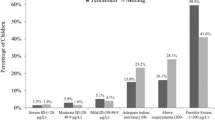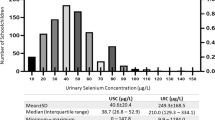Abstract
Iodine deficiency (ID) and related disorders are still major, yet unresolved health concerns. Recently, in a systematic survey of schoolage children (SAC), we reported severe to moderate ID, in Ankara and three cities from Black Sea region of Turkey. The current study attempted to evaluate selenium (Se) status, thiocyanate (SCN−) overload, and their possible contribution to the goiter endemics and thyroid hormone profile observed in these cities. Thyroid ultrasonography was performed and serum Se, SCN−, thyroid hormones, sensitive TSH (sTSH) levels, and urinary iodine concentrations (UICs) were determined from 251 SAC (9–11 yr old).
Thyroid volumes (TVs) exceeding recommended upper normal limits and median UIC indicated goitre endemics and moderate to severe ID in the areas studied. Mean serum SCN− concentrations were found to be greater than the controls from the literature. The UIC/SCN− ratio was found to be lowest in Bayburt and Trabzon denoting that SCN− overload may contribute to the goiter endemics. Serum Se concentrations represent a marginal deficiency in the four areas studied. No significant correlations between serum Se concentrations and the other parameters studied (i.e., TV, SCN−, thyroid hormones, sTSH, UIC) was detected.
In conclusion, this study showed that selenium is also marginally deficient in the iodine-deficient endemic areas studied, but this has little or no impact on the thyroid hormone profile and the goiter endemics. SCN− overload may contribute to the endemics, especially for the areas where iodine is severely deficient. An effective iodine supplementation program will not only resolve the goiter endemics but also the consequence of SCN− overload as well in the endemic goiter areas studied.
Similar content being viewed by others
References
Anon., Global IDD status, IDD Newslett. 15, 18–19 (1999).
F. Delange, Cassava and the thyroid, in Environmental Goitrogenesis, E. Gaitan, ed., CRC, Boca Raton, FL, pp. 173–180 (1989).
J. B. Vanderpas, B. Contempre, N. L. Duale, W. Goosens, N. Bebe, R. Thorpe, et al., Iodine and selenium deficiency associated with cretinism in Northern Zaire, Am. J. Clin. Nutr. 52, 1087–1093 (1990).
D. L. St. Germain and A. V. Galton, The deiodinase family of selenoproteins, Thyroid 7, 655–668 (1997).
G. Erdoğan, M. F. Erdoğan, F. Delange, H. Sav, and S. Güllü, Moderate to severe iodine deficiency diminishes school success in three endemic goitre areas from the Black-Sea region and the capital of Turkey, J. Endocrinol. Invest. 22(6, Suppl.), 98 (1999).
P. Arslan, G. Pekcan, and A. A. Dervişoğlu, in 15 ilde beslenme e itimi (in Turkish), Ankara (1996).
P. Vitti, E. Martino, F. Aghini-Lombardi, T. Rago, L. Antonangelli, D. Maccherini, et al., Thyroid volume measurement by ultrasound in children as a tool for the assessment of mild iodine deficiency, J. Clin. Endocrinol. Metab. 79, 600–603 (1994).
J. Brunn, U. Blocjk, J. Ruf, B. I. Kunze, W. P. Kunza, and P. C. Scriba, Volumetrie der schildrüsenlappen mittels real-time-sonographie, Dtsch. Med. Wochenschr. 106, 1338–1341 (1981).
World Health Organization (WHO), International Council for Control of Iodine Deficiency Disorders (ICCIDD), Recommended normative values for thyroid volume in children aged 6–15 years, Bull. WHO 75, 95–98 (1997).
E. B. Sandell and I. M. Kolthoff, Micro determination of iodine by a catalytic method, Mikrochem. Akta 1, 9 (1937).
J. T. Dunn, E. H. Crutchfield, R. Gutekunst, and A. D. Dunn, Methods for measuring iodine in urine, International Council for Control of Iodine Deficiency Disorders (1993).
K. McLaughlin, D. Dadgar, and M. R. Symth, Determination of selenium in blood plasma and serum by flow injection hydride generation atomic absorption spectrometry, Analyst 115, 275–279 (1990).
M. H. Barker, Thiocynates in blood, JAMA 106, 762–766 (1932).
R. F. Burk, W. N. Pearson, R. P. Wood, and F. Viteri, Blood selenium levels and in vitro red blood cell uptake 75Se in kwashiorkor, J. Clin. Nutr. 20, 723–730 (1967).
P. Fondu, C. Hariga-Muller, and N. Mozes, Protein energy malnutrition and anemia in Kivu, Am. J. Clin. Nutr. 31, 46–51 (1978).
M. H. N. Golden and D. Ramdath, Free radicals in the pathogenesis of kwashiorkor, in Proceedings of the XIII International Congress of Nutrition, T. G. Taylor and N. K. Jenkins, eds., John Libbey Eorotext Ltd., Paris (1986).
B. Corvilain, J. Van Sande, E. Laurent, and J. E. Dumont, The H2O2-generating system modulates protein iodination and the activity of the pentose phosphate pathway in dog thyroid, Endocrinology 128, 799–804 (1991).
B. Contempre, J. Vanderpas, N. Duale, A. T. Diplock, and C. H. Thilly, Central and/or peripheral effects of selenium on thyroid metabolism in human, in Progress in Thyroid Research, Gordon, Gross, and Henneman, eds., Balkema, Rotterdam, pp. 757–760 (1991).
B. Contempre, J. E. Dumont, B. Ngo, C. H. Thilly, A. T. Diplock, and J. Vanderpas, Effects of selenium supplementation in hypothyroid subjects of an iodine and selenium deficient area: the possible danger of discriminate supplementation of iodine-deficient subjects with selenium, J. Clin. Endocrinol. Metab. 73, 213–215 (1991).
R. E. Litov and G. F. Combs, Jr., Selenium in pediatric nutrition, Pediatrics 87, 339–342 (1991).
K. Mengübas, N. A. Diab, G. Gökmen, Y. O. Ataman, A. Çavdar, and S. Cin, Selenium status of healthy Turkish children, Biol. Trace Element Res. 54, 163–172 (1996).
M. Özata, M. Salk, A. Aydın, S. Sayın, Ç. Öktenli, Z. Beyhan, et al., Iodine and zinc, but not selenium deficiency exists in a male Turkish population, Biol. Trace Element Res. 69, 211–216 (1999).
R. Lagasse, P. Bourdoux, and P. Courtois, Influence of the dietary balance of iodine/thiocyanate and protein on thyroid function in Adults and young infants, in Nutritional Factors Involved in the Goitrogenic Action of Cassava, F. Delange, F. B. Iteke, and A. M. Ermans, eds., International Research Center Edition, Canada, p. 34 (1982).
M. Gross, M. Oertel, and J. Kohrle, Differential sselenium-dependent expression of type I 5′-deiodinase and gluthatione peroxidase in the porcine epithelial kidney cell line LLC-PK1, Biochem. J. 306, 851–856 (1995).
Author information
Authors and Affiliations
Rights and permissions
About this article
Cite this article
Erdoğan, M.F., Erdoğan, G., Sav, H. et al. Endemic goiter, thiocyanate overload, and selenium status in school-age children. Biol Trace Elem Res 79, 121–130 (2001). https://doi.org/10.1385/BTER:79:2:121
Received:
Revised:
Accepted:
Issue Date:
DOI: https://doi.org/10.1385/BTER:79:2:121




